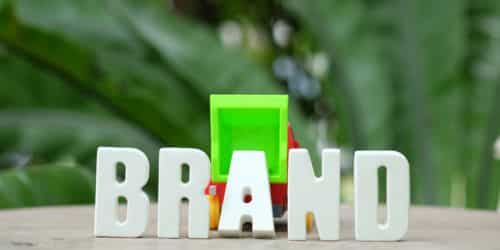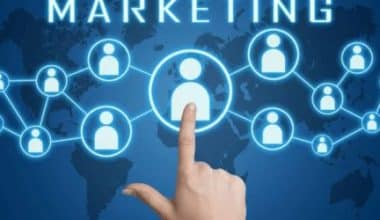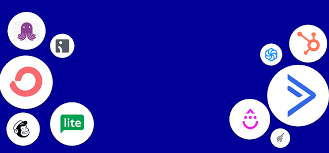Do you want to expand your brand’s visibility and connect with more of the important customers? These brand activation ideas and examples I will explain in this article will assist you in developing genuine connections with your target audience that will benefit your company. As a business owner or marketing professional, you always want to reach more people with your brand’s message, products, and services. Unfortunately, it’s not always easy to achieve this. How will your business ever succeed in the face of a deluge of webinars, a crowded online market, and competitors vying for customers? It sounds like you need to invest in a brand activation marketing strategy.
Key Points
- Brand activation is useful when launching a new product line or business. It always requires a unique interactive experience to attract loyal customers.
- The following components are some of the most successful brand activation features: surprise, dreaming & sharing, and giveaways.
- Brand activation ideas include creating a unique experience, encouraging a social media challenge, considering partnerships with other brands, solving problems, and promoting your brand’s values.
- Brand activation’s goals include increasing visibility, enhancing awareness, reinforcing propositions, increasing customer involvement, and fostering a relationship of trust with customers.
What Is Brand Activation in Marketing?
Brand activation refers to a marketing strategy that uses one or more of six distinct disciplines—which help bring a brand to life by engaging and interacting with the consumer personally—to enhance a brand’s image and drive certain customer action.
A unique brand experience can take place in a classy, fashion-forward setting, such as a five-star hotel or restaurant, or it can be more target-based, such as by giving the appropriate samples to the appropriate individuals.
Brand activation highly relies on elements of surprise and creativity.
A new local or even online brand can establish a connection with its target audience through a multi-touch brand experience offered by innovative ideas in a brand activation campaign.
Brand activation is useful when launching a new product line or business. It always requires a unique interactive experience to attract loyal customers.
Brand activation marketing campaigns are a great way for businesses to differentiate themselves. Various strategies include influencer marketing, in-store or online events, product sampling, and giveaways.
A brand activation marketing event is typically like a party, where attendees enjoy themselves and exchange ideas and experiences with the brand.
Why Are Brand Activations Important?

Brand activations can benefit businesses by effectively introducing new items or brands and gaining insightful customer feedback. In the future, when potential customers search for a certain good or service, visuals can help them remember a brand. Brand activations can give your customers engaging images they can associate with your products or services.
Some brand activations garner media coverage or attention on social media, which can help a business generate loyalty. Including a well-known public figure or planning an enjoyable activity for attendees could help your business become more relevant to the wider audience. Moreover, brand activations can be a powerful tool for building relationships with your target market.
Brand Activation Features
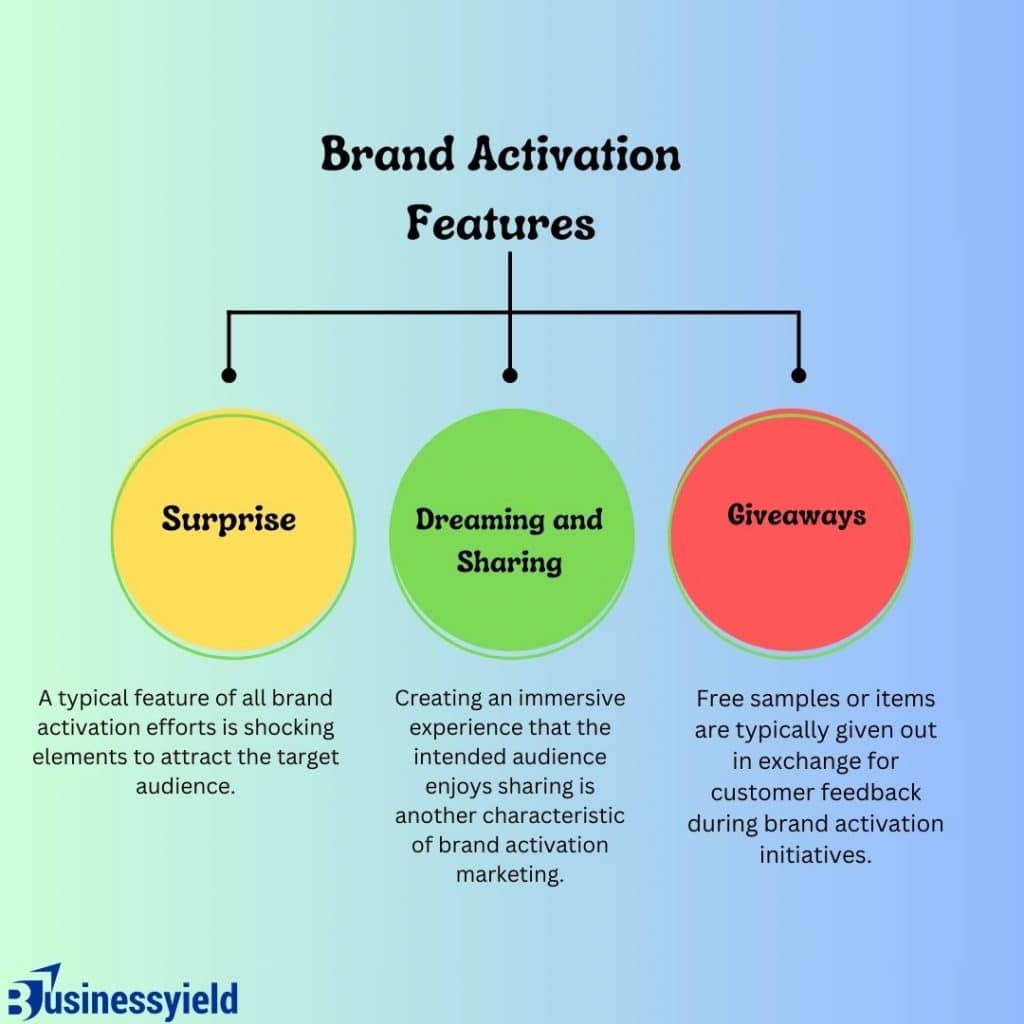
As we just discussed, successful brand activations are unique experiences that share certain things. The following components are some of the most successful brand activation features:
#1. Surprise
A typical feature of all brand activation efforts is shocking elements to attract the target audience.
Several companies use this tactic to stand out from the crowd. For example, the London-based Lipton Tea Company set up a giant yellow water slide in the city’s center, and Google Play distributed cupcakes as part of their campaign!
Your mind records aspects that appear out of sequence but are yet pleasurable, resulting in a delightful brand experience.
#2. Dreaming and Sharing
Creating an immersive experience that the intended audience enjoys sharing is another characteristic of brand activation marketing.
To attract the proper customers and get their attention, brands must understand the goals and aspirations of their target market.
In 2018, Westworld series fans enjoyed a real-life HBO event in Austin, Texas, where over 40 “hosts” (actors in the Westworld TV series) guided and entertained them.
El Diablo, a mechanical bull whose target market enjoys riding and sharing, helped the Durango Boots brand achieve this.
#3. Giveaways
Free samples or items are typically given out in exchange for customer feedback during brand activation initiatives.
Companies can utilize a variety of gifts, such as promotions or free samples, to engage their target market and keep them entertained.
Though they can vary greatly, all brand activation experiences have the same goal of raising brand awareness and engaging the target market.
Brand Activation Types

Many brand activation types are popular among new and established companies, depending on the size of the business and its target demographic. Luxurious, reputable companies frequently use experimental marketing to introduce new products, raise brand awareness, or show off their imaginative, interactive designs during concerts or festivals. Conversely, smaller brands typically choose more economical strategies.
#1. Experimental Marketing for Brand Activation
Prominent companies often use experimental marketing to build direct client relationships. Experimental marketing offers a multi-touch brand impression and a distinctive interactive brand or product experience.
Creative brand-sponsored experiences take many forms, from Contour’s adult-sized baby strollers to Sonic’s square milkshakes sold exclusively in return for Instagram pictures. This is the realm of experimental marketing.
In modern examples of experimental marketing, often a combination of online and offline brand activation campaigns can be seen.
Everything from live contests to social media lives and giveaway campaigns, having influencers in-store or at parties, and online streaming. With these solutions, brands can reach millions of impressions worldwide.
#2. Promotional Marketing for Brand Activation
Through social media campaigns and digital marketing tools, new companies and startups attempt promotional marketing to draw in customers or break into untapped areas.
Contemporary brands employ various promotional marketing strategies, such as social media campaigns and influencer marketing, to meet significant brand activation objectives.
Promotional marketing, which includes handouts of free samples, competitions, social media freebies, special offers, reward loyalty programs, and other initiatives, helps build a devoted customer base and raises brand awareness.
Promotional marketing is a big umbrella for all other activities that result in the promotion of the brand.
Popular social media platforms have a huge user base, which new companies use to launch brand activation campaigns that reach previously unthinkable heights.
Social media influencer campaigns are usually curated by brands that hand-pick a set of celebrities or influencers for their events, only to have them broadcasted to their network of followers and increase their brand awareness levels.
Influencers on social media run competitions that draw large participation from users, or occasionally; companies send free samples or coupons to their followers.
#4. In-Store Retail Brand Activation
Publicly launching neighborhood stores and well-known brand stores is another scenario that can highlight innovative concepts and create unexpected encounters.
In-store locations allow brands to engage with customers in fresh and imaginative ways. A shop’s visibility and impressions are enhanced when a select group of well-known influencers are invited to the opening.
Another popular trend in brand activation marketing is in-store social media engagement, where customers have a unique brand experience.
#5. Product Sampling for Brand Activation
Following the COVID-19 pandemic, various forms of product sampling underwent structural modifications in response to hygiene concerns in shared in-store product samplings, particularly about cosmetics and skincare items.
Nowadays, the most common method for end users to engage with a business and its products is through personalized, usable product samples.
Brands can target the relevant people for product samples and execute a successful brand activation marketing strategy using physical and digital technologies.
The lines between the various forms of brand activation are typically hazy since the practice is equal parts science and art. A successful brand activation campaign is a combination of several types. Every brand requires a different approach to brand activation.
What Are the Goals of Brand Activation?
Whether a brand is new or well-established, a brand activation campaign can help keep the business and its brand current and in demand. Effectively, it can help a brand become more popular, transform its reputation, attract customers, and become a living, breathing entity. Among the goals of brand activation are:
#1. To Increase Visibility
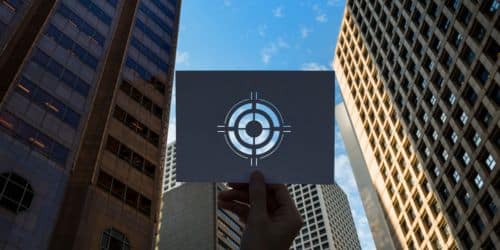
A business might plan brand activation campaigns even if its brand is already well-known or somewhat present to boost visibility and attract new clients. For instance, Glade, a brand owned by SC Johnson, devised an imaginative and entertaining sampling campaign to attract customers and draw attention to itself. In collaboration with Walmart, the business incorporated packing pillows into its product prototypes. In the first week, the brand’s sales on Walmart.com increased by 83%.
#2. To Enhance Awareness

The majority of customers do not recognize new brands or their merchandise. Brand activation allows these businesses to connect with their target market and raise awareness. For instance, the local Peruvian dairy brand Laive received 800,000 likes, 22,100 comments, and 63,800 shares on social media. The business employed Italian drivers and put them in some of the most well-known eateries. These drivers offered their patrons a complimentary parmesan cheese to go with their meals by trailing the delivery man of the establishments above. The brand raised awareness and attracted a lot of attention with its actions.
#3. To Reinforce Proposition

Brand activation improves and reinforces a brand’s value proposition. Businesses use brand activation to remind customers of their goals and objectives. For example, the American multinational firm Nike created and distributed a doll ball shaped like a ball as part of a brand activation campaign to encourage its audience to pursue sports, particularly girls. The brand engaged with customers through this campaign and reaffirmed its “Just Do It” goal statement.
#4. To Increase Customer Involvement
Customer engagement is the outcome of brand activation, which assists in building a bridge or connection between the brand and the customer. The willingness of a customer to actively participate and communicate with a brand is referred to as customer engagement. One of a brand activation campaign’s most crucial goals is to engage and interact with consumers. Companies that use experiential marketing for activation can identify this type of engagement.
#5. To Foster a Relationship of Trust with the Customers

Establishing consumer confidence in the brand and its products is another goal of brand activation. Customer loyalty, which results in recurring purchases, is frequently fueled by trust in a brand. Through the creation of word-of-mouth and referral marketing efforts, businesses can even use this devotion to boost sales.
Brand Activation Ideas
I oversaw a brand activation campaign for a new energy drink a few years back. Drawing from my experience, we organized an interactive pop-up event at a local gym. Attendees were challenged to try our drink before a workout. The surprise element? We offered free personalized workout plans with every drink purchased. Witnessing firsthand the excitement and engagement of participants, I realized the power of experiential marketing. By understanding our target audience’s needs and desires, we created a memorable experience that fostered genuine connections. This taught me that brand activation promotes and forges meaningful relationships with consumers. In addition, I’ve prepared a few ideas to help you feel motivated for your upcoming campaign and establish unique and innovative connections with your leads and customers.
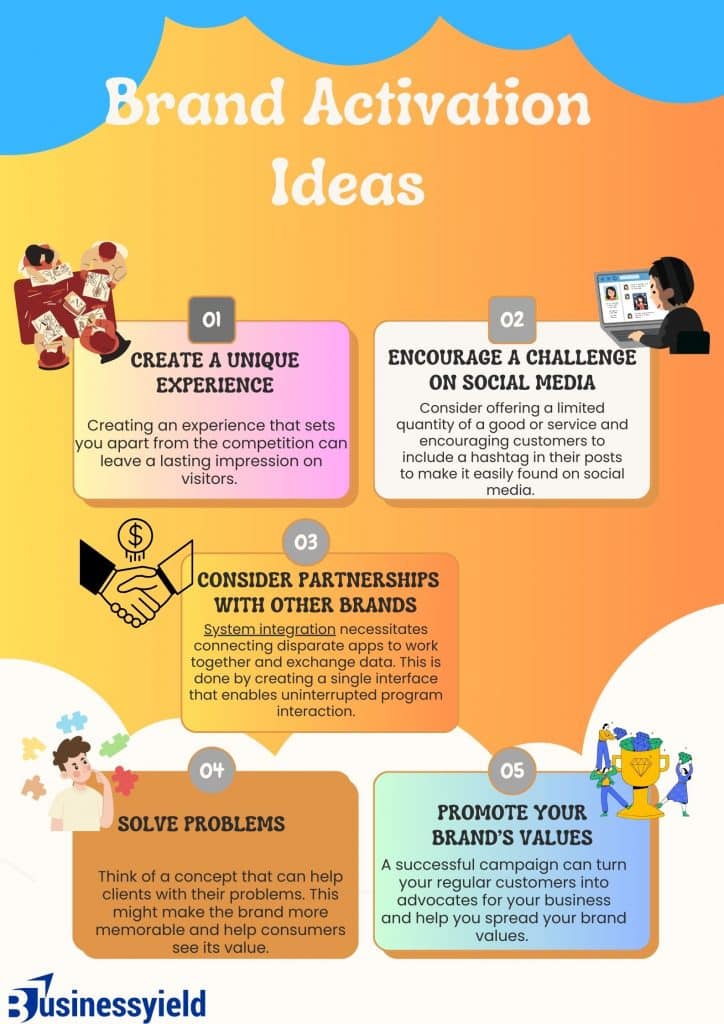
#1. Create a Unique Experience
Creating an experience that sets you apart from the competition can leave a lasting impression on visitors. To demonstrate how much faster several brands’ folding chairs fold, a company that wants to offer the fastest folding chair, for instance, could organize a race among them. This could be an enjoyable and memorable experience emphasizing the product’s competitive advantage.
Consider offering a limited quantity of a good or service and encouraging customers to include a hashtag in their posts to make it easily found on social media. A company could, for example, design a new dog food taste and package it with a unique bowl bearing the brand’s name. This would encourage customers to purchase the bags and share pictures of their dogs eating from the bowl on social media.
#3. Consider Partnerships with Other Brands
It is also smart to locate a non-competing brand with a comparable audience. You can work on a project, campaign, event, or something else entirely.
There are countless instances to be found everywhere. For example, the collaboration between Uber and Spotify resulted in the “Soundtrack for Your Ride” promotion. More leads interested in these products and a larger audience are two positive outcomes of this campaign.
#4. Solve Problems
Think of a concept that can help clients with their problems. This might make the brand more memorable and help consumers see its value. For instance, if an energy bar company provides samples of its product at a marathon, this could satisfy a customer’s hunger and provide them with energy for the race. They might be keen to buy energy bars in the future because of how well they prepared them for exercise.
#5. Promote Your Brand’s Values
A successful campaign can turn your regular customers into advocates for your business and help you spread your brand values. Use eye-catching graphics to communicate your ideas to reach a larger audience and make a stronger impression.
You can always produce something amazing and surprise your audience if you have abundant resources. Various brands attest that innovation and astute resource use can greatly benefit your business. However, following the customer’s engagement should allow you to gauge your level of success.
How to Implement Brand Activation
Implementing a brand activation involves several key steps to ensure that the activation effectively communicates your brand message and engages your target audience. Below I have provided a comprehensive checklist you can follow:
How to Implement Brand Activation Businessyield Checklist
Brand Activation Examples
Whether you are just starting your business, your company plans to launch a new product that needs some extra hype, or your brand strives for more recognition, brand activation is for you. Here are several outstanding examples. Let’s dive in.
#1. Calm: Project 84
Suicide is the leading cause of mortality for men in the UK between the ages of 18 and 45. The UK’s leading TV network’s building was topped by 84 life-size sculptures of hooded men, representing the number of men who commit suicide in the country each week. The sculptures were made by the charity CALM, which works to prevent suicide.
Each sculpture is distinct and narrates the tale of a real individual who took their own life. The TV network CALM collaborated with ITV and also agreed to air the campaign on their morning show and commit three days of programming to male suicide to generate as much attention as possible for male suicide prevention. Additionally, the campaign circulated a petition urging the government to take suicide more seriously and take greater action to help solve the urgent issue.
#2. Vitamin Water: Brandon
This is a fantastic example of brand activation, according to my colleague Stan Lee. The Vitamin Water ad “Brandon” made him laugh aloud, even though he doesn’t normally pay attention to subway advertisements. Lee then observed someone holding a sign that read, “Need Handshaking Tips?” a few weeks later while strolling around Boston and passing Forbes’ Under 30 Summit.
That person was a part of Vitamin Water’s “Brandon” marketing campaign. Brandon’s business cards, some swag, and even bottles of Vitamin Water were distributed by other campaign members.
The funniest (and most impressive) part of the “Brandon” marketing campaign was that the members acted like they worked for Brandon.
Vitamin Water’s “Brandon” campaign struck a chord with so many people because the company went above and beyond to engage with its target demographic and bring the advertisement to life rather than merely making subway travelers smile while heading to work. Brandon accepts all of his inquiries on LinkedIn to add an even more personal touch.
#3. HubSpot: INBOUND
HubSpot hosts the INBOUND event annually. Through this brand activation, we aim to increase brand recognition, encourage customer sign-ups, and, ultimately, provide our customers with the best possible service as a business.
Because INBOUND is a one-time event that promotes engagement and interactivity for HubSpot each year, it’s a great example of brand activation.
We can offer our customers and any business that wishes to learn from the best of the best an experience through INBOUND.
#4. Revolve: Revolve Festival
Revolve’s annual Revolve Festival at Coachella is a great example of brand activation, or at least it has been for several years. This is frequently referred to as the annual celebrity party.
Celebrities and micro- and macro-influencers are hand-picked by Revolve to attend music festivals and parties.
Revolve Fest became virtually popular on social media annually due to the company’s emphasis on influencer marketing. Influencer marketing boosts sales of the apparel line and other products. Influencers account for 70% of the company’s sales.
Every one of these events attempts to increase sales and brand recognition through brand activation.
#5. HBO: SXSWestworld
In Austin, Texas, HBO created a small version of the show’s Wild West-themed amusement park for SXSW 2018 attendees to explore to promote the second season of their popular show Westworld.
With over 40 “hosts” who guided attendees on their unique narrative within Sweetwater, they felt like they were in an episode of Westworld, traversing a town full of trotting horses, troublemaking bandits, and money-hungry gamblers.
Throughout the park, hints about new characters and the plot of season two were also given, adding to the tension and excitement surrounding the show’s impending release.
How Do You Create a Brand Activation?
Creating a brand activation involves strategic steps to engage consumers, increase brand awareness, and drive sales. Here’s a comprehensive checklist to guide you through the process:
Businessyield checklist on how you create a brand activation
Is Brand Activation a Marketing?
Yes, brand activation is a type of marketing. It’s a strategy meant to give customers an exceptional and unforgettable experience that enables them to engage with a company more deeply.
Bottom Line
Organizing a campaign or brand activation event can help you build brand recognition and impressions and eventually attract new clients. You can personally engage and communicate with your audience using strategies like influencer marketing, digital campaigns, experiential marketing, and live or virtual events.
Making your experiences shareable, being innovative, and keeping your audience in mind are all essential for successful brand activation.
Similar Articles
- Why Experiential Marketing is Key to Successful Brand Activations
- Below-the-Line Advertising: Definitions, Examples, Marketing Ideas
- CAMPAIGN MANAGER: Meaning, Duty & Salary
